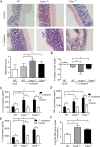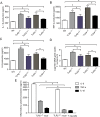TLR2/TLR4 activation induces Tregs and suppresses intestinal inflammation caused by Fusobacterium nucleatum in vivo
- PMID: 29016688
- PMCID: PMC5633168
- DOI: 10.1371/journal.pone.0186179
TLR2/TLR4 activation induces Tregs and suppresses intestinal inflammation caused by Fusobacterium nucleatum in vivo
Abstract
Toll-like receptors (TLRs) 2 and 4 play critical roles in intestinal inflammation caused by Fusobacterium nucleatum (F. nucleatum) infection, but the role of TLR2/TLR4 in regulation of proinflammatory cytokines remains unknown. In this study, through microarray analysis and qRT-PCR, we showed that TLR2/TLR4 are involved in the F. nucleatum-induced inflammatory signaling pathway in Caco-2 cells, C57BL/6 mice and human clinical specimens. In TLR2-/- and TLR4-/- mice, F. nucleatum infection resulted in increased colonization of the bacteria and production of the proinflammatory cytokines IL-8, IL-1β and TNF-α. In addition, the ratio of Foxp3+ CD4+ T cells in the total CD4+ T cells in TLR2-/- and TLR4-/- mice was less than that in wild-type mice, and the ratio in hybrid mice was more than that in knockout mice, which suggested that TLR2/TLR4 mediated the number of Tregs. Furthermore, it was observed that inflammatory cytokine levels were reduced in TLR2-/- mice after Treg transfer. Thus, these data indicate that TLR2/TLR4 regulate F. nucleatum-induced inflammatory cytokines through Tregs in vivo.
Conflict of interest statement
Figures




Similar articles
-
Fusobacterium nucleatum induces fetal death in mice via stimulation of TLR4-mediated placental inflammatory response.J Immunol. 2007 Aug 15;179(4):2501-8. doi: 10.4049/jimmunol.179.4.2501. J Immunol. 2007. PMID: 17675512
-
Global TLR2 and 4 deficiency in mice impacts bone resorption, inflammatory markers and atherosclerosis to polymicrobial infection.Mol Oral Microbiol. 2017 Jun;32(3):211-225. doi: 10.1111/omi.12165. Epub 2016 Jul 20. Mol Oral Microbiol. 2017. PMID: 27224005 Free PMC article.
-
Fusobacterium nucleatum Secretes Outer Membrane Vesicles and Promotes Intestinal Inflammation.mBio. 2021 Mar 2;12(2):e02706-20. doi: 10.1128/mBio.02706-20. mBio. 2021. PMID: 33653893 Free PMC article.
-
Association of Fusobacterium nucleatum with immunity and molecular alterations in colorectal cancer.World J Gastroenterol. 2016 Jan 14;22(2):557-66. doi: 10.3748/wjg.v22.i2.557. World J Gastroenterol. 2016. PMID: 26811607 Free PMC article. Review.
-
The onco-immunological implications of Fusobacterium nucleatum in breast cancer.Immunol Lett. 2021 Apr;232:60-66. doi: 10.1016/j.imlet.2021.02.007. Epub 2021 Feb 26. Immunol Lett. 2021. PMID: 33647328 Review.
Cited by
-
HMGB1/TLR4 Signaling Affects Regulatory T Cells in Acute Lung Injury.J Inflamm Res. 2021 Apr 19;14:1551-1561. doi: 10.2147/JIR.S302967. eCollection 2021. J Inflamm Res. 2021. PMID: 33907436 Free PMC article.
-
Microbe-Mediated Activation of Toll-like Receptor 2 Drives PDL1 Expression in HNSCC.Cancers (Basel). 2021 Sep 24;13(19):4782. doi: 10.3390/cancers13194782. Cancers (Basel). 2021. PMID: 34638266 Free PMC article.
-
Changes in the Microbiome Profile in Different Parts of the Intestine in Piglets with Diarrhea.Animals (Basel). 2022 Jan 28;12(3):320. doi: 10.3390/ani12030320. Animals (Basel). 2022. PMID: 35158643 Free PMC article.
-
Intestinal Alkaline Phosphatase Prevents Sulfate Reducing Bacteria-Induced Increased Tight Junction Permeability by Inhibiting Snail Pathway.Front Cell Infect Microbiol. 2022 May 26;12:882498. doi: 10.3389/fcimb.2022.882498. eCollection 2022. Front Cell Infect Microbiol. 2022. PMID: 35694541 Free PMC article.
-
A Lipopolysaccharide-Enriched Cow's Milk Allergy Microbiome Promotes a TLR4-Dependent Proinflammatory Intestinal Immune Response.J Immunol. 2024 Feb 15;212(4):702-714. doi: 10.4049/jimmunol.2300518. J Immunol. 2024. PMID: 38169331 Free PMC article.
References
-
- Allen-Vercoe E, Strauss J, Chadee K. Fusobacterium nucleatum: an emerging gut pathogen? Gut Microbes. 2011;2(5):294–8. Epub 2011/11/10. doi: 10.4161/gmic.2.5.18603 . - DOI - PubMed
-
- Jess T, Rungoe C, Peyrin-Biroulet L. Risk of colorectal cancer in patients with ulcerative colitis: a meta-analysis of population-based cohort studies. Clin Gastroenterol Hepatol. 2012;10(6):639–45. Epub 2012/02/01. doi: 10.1016/j.cgh.2012.01.010 . - DOI - PubMed
-
- Liu H, Redline RW, Han YW. Fusobacterium nucleatum induces fetal death in mice via stimulation of TLR4-mediated placental inflammatory response. J Immunol. 2007;179(4):2501–8. Epub 2007/08/07. . - PubMed
-
- Kostic AD, Chun E, Robertson L, Glickman JN, Gallini CA, Michaud M, et al. Fusobacterium nucleatum potentiates intestinal tumorigenesis and modulates the tumor-immune microenvironment. Cell Host Microbe. 2013;14(2):207–15. Epub 2013/08/21. doi: 10.1016/j.chom.2013.07.007 ; PubMed Central PMCID: PMC3772512. - DOI - PMC - PubMed
-
- Sears CL, Garrett WS. Microbes, microbiota, and colon cancer. Cell Host Microbe. 2014;15(3):317–28. Epub 2014/03/19. doi: 10.1016/j.chom.2014.02.007 ; PubMed Central PMCID: PMC4003880. - DOI - PMC - PubMed
MeSH terms
Substances
LinkOut - more resources
Full Text Sources
Other Literature Sources
Molecular Biology Databases
Research Materials

